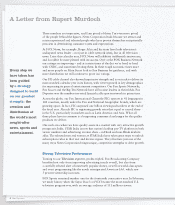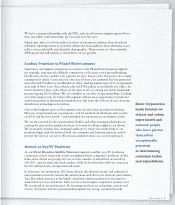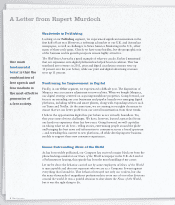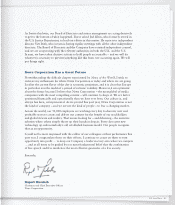Twenty-First Century Fox 2011 Annual Report Download - page 15
Download and view the complete annual report
Please find page 15 of the 2011 Twenty-First Century Fox annual report below. You can navigate through the pages in the report by either clicking on the pages listed below, or by using the keyword search tool below to find specific information within the annual report.
Management’s Discussion and Analysis of Financial Condition and Results of Operations (continued)
entertainment, including sale and rental of DVDs and Blu-rays, video-on-demand and pay-per-view television, on-line and mobile distribution,
premium subscription television, network television and basic cable and syndicated television exploitation. Television series initially produced for
the networks and first-run syndication are generally licensed to domestic and international markets concurrently and subsequently released in
seasonal DVD and Blu-ray box sets. More successful series are later syndicated in domestic markets. The length of the revenue cycle for television
series will vary depending on the number of seasons a series remains in active production and, therefore, may cause fluctuations in operating
results. License fees received for television exhibition (including international and U.S. premium television and basic cable television) are recorded
as revenue in the period that licensed films or programs are available for such exhibition, which may cause substantial fluctuations in operating
results.
The revenues and operating results of the Filmed Entertainment segment are significantly affected by the timing of the Company’s theatrical
and home entertainment releases, the number of its original and returning television series that are aired by television networks and the number of
its television series in off-network syndication. Theatrical and home entertainment release dates are determined by several factors, including timing
of vacation and holiday periods and competition in the marketplace. The distribution windows for the release of motion pictures theatrically and
in various home entertainment products and services (including subscription rentals, rental kiosks and Internet streaming services), have been
compressing and may continue to change in the future. A further reduction in timing between theatrical and home entertainment releases could
adversely affect the revenues and operating results of this segment.
The Company enters into arrangements with third parties to co-produce many of its theatrical productions. These arrangements, which are
referred to as co-financing arrangements, take various forms. The parties to these arrangements include studio and non-studio entities, both
domestic and international. In several of these agreements, other parties control certain distribution rights. The Filmed Entertainment segment
records the amounts received for the sale of an economic interest as a reduction of the cost of the film, as the investor assumes full risk for that
portion of the film asset acquired in these transactions. The substance of these arrangements is that the third-party investors own an interest in the
film and, therefore, receive a participation based on the respective third-party investor’s interest in the profits or losses incurred on the film.
Consistent with the requirements of Financial Accounting Standards Board Accounting Standards Codification (“ASC”) 926 “Entertainment –
Films,” (“ASC 926”), the estimate of a third-party investor’s interest in profits or losses incurred on the film is determined by reference to the
ratio of actual revenue earned to date in relation to total estimated ultimate revenues.
Operating costs incurred by the Filmed Entertainment segment include: exploitation costs, primarily theatrical prints and advertising and home
entertainment marketing and manufacturing costs; amortization of capitalized production, overhead and interest costs; and participations and
talent residuals. Selling, general and administrative expenses include salaries, employee benefits, rent and other routine overhead.
The Company competes with other film studios, such as Disney, Paramount, Sony, Universal, Warner Bros. and independent film producers in
the production and distribution of motion pictures, DVDs and Blu-rays. As a producer and distributor of television programming, the Company
competes with studios, television production groups and independent producers and syndicators, such as Disney, Sony, NBC Universal, Warner
Bros. and Paramount Television, to sell programming both domestically and internationally. The Company also competes to obtain creative talent
and story properties, which are essential to the success of the Company’s filmed entertainment businesses.
Direct Broadcast Satellite Television
The Direct Broadcast Satellite Television (“DBS”) segment’s operations consist of SKY Italia, which provides basic and premium programming
services via satellite and broadband directly to subscribers in Italy. SKY Italia derives revenues principally from subscriber fees. The Company
believes that the quality and variety of programming, audio and interactive programming including personal video recorders, quality of picture
including high definition channels, access to service, customer service and price are the key elements for gaining and maintaining market share.
SKY Italia’s competition includes companies that offer video, audio, interactive programming, telephony, data and other information and
entertainment services, including broadband Internet providers, digital terrestrial transmission (“DTT”) services, wireless companies and
companies that are developing new media technologies. Since 2003, SKY Italia had been prohibited from owning a DTT frequency or providing a
pay television DTT offer under a commitment made to the European Commission (the “EC”) through December 31, 2011. In July 2010, the EC
modified this restriction to allow SKY Italia to bid for one DTT frequency. However, if SKY Italia were to successfully bid for such a DTT
frequency, the EC would limit SKY Italia’s use of such frequency to exclusively free-to-air channels for 5 years subsequent to its acquisition.
SKY Italia’s most significant operating expenses are those related to the acquisition of entertainment, movie and sports programming and
subscribers and the production and expenses related to operating the technical facilities. Operating expenses related to sports programming are
generally recognized over the course of the related sport season, which may cause fluctuations in the operating results of this segment.
Publishing
The Company’s Publishing segment consists of the Company’s newspapers and information services, book publishing and integrated
marketing services businesses.
Revenue is derived from the sale of advertising space, newspapers, books and subscriptions, as well as licensing. Adverse changes in general
market conditions for advertising may affect revenues. Circulation and subscription revenues can be greatly affected by changes in the prices of the
Company’s and/or competitors’ products, as well as by promotional activities.
Operating expenses include costs related to paper, production, distribution, editorial, commissions and royalties. Selling, general and
administrative expenses include promotional expenses, salaries, employee benefits, rent and other routine overhead. The Company expects that
advancements in technology will introduce new challenges and opportunities for digital distribution by the publishing businesses.
The Publishing segment’s advertising volume, circulation and the price of paper are the key variables whose fluctuations can have a material
effect on the Company’s operating results and cash flow. The Company has to anticipate the level of advertising volume, circulation and paper
2011 Annual Report 13
























